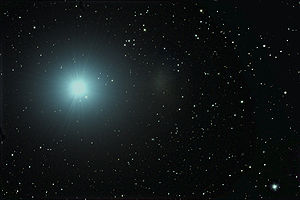- Leo I (dwarf galaxy)
-
Leo I Observation data (J2000 epoch) Constellation Leo Right ascension 10h 08m 27.4s[1] Declination +12° 18′ 27″[1] Redshift 285 ± 2 km/s[1] Distance 820 ± 70 kly (250 ± 20 kpc)[2][3] Type E;dSph[1] Apparent dimensions (V) 9′.8 × 7′.4[1] Apparent magnitude (V) 11.2[1] Notable features Milky Way satellite Other designations UGC 5470,[1] PGC 29488,[1] DDO 74,[1] A1006,[1] Harrington-Wilson #1,[1] Regulus Dwarf[1] See also: Galaxy, List of galaxies Leo I is a dwarf spheroidal galaxy in the constellation Leo. At about 820,000 light-years distant, it is a member of the Local Group of galaxies and is thought to be one of the most distant satellites of the Milky Way galaxy. It was discovered in 1950 by Wilson on photographic plates of the National Geographic Society - Palomar Observatory Sky Survey, which were taken with the 48-inch Schmidt camera at Palomar Observatory.[4][5]
Contents
Mass
The measurement of radial velocities of some bright red giants in Leo I have made possible to measure its mass. It was found to be at least (2.0 ± 1.0) × 107 MSun. The results are not conclusive, and do not deny or confirm the existence of a large dark matter halo around the galaxy. However, it seems to be certain that the galaxy does not rotate.[5]
It has been suggested that Leo I is a tidal debris stream in the outer halo of the Milky Way. This hypothesis has not been confirmed, however.[5]
Star formation
Typical to a dwarf galaxy, the metallicity of Leo I is very low, only one percent that of the Sun. Gallart et al. (1999) deduce from Hubble Space Telescope observations that the galaxy experienced a major increase (accounting for 70% to 80% of its population) in its star formation rate between 6 Ga and 2 Ga (billion years ago). There is no significant evidence of any stars that are more than 10 Ga old. About 1 Ga ago, star formation in Leo I appears to have dropped suddenly to an almost negligible rate. Some low-level activity may have continued until 200-500 Ma. Therefore it may be the youngest dwarf spheroidal satellite galaxy of the Milky Way. In addition, the galaxy may be embedded in a cloud of ionized gas with a mass similar to that of the whole galaxy.[5][6]
Globular clusters
No globular clusters have been found in the galaxy.[5]
Regulus
Leo I is located only 12 arc minutes from Regulus, the brightest star in the constellation. For that reason, the galaxy is sometimes called the Regulus Dwarf. Scattered light from the star makes studying the galaxy more difficult, and it was not until the 1990s that it was detected visually.[4][5]
References
- ^ a b c d e f g h i j k l "NASA/IPAC Extragalactic Database". Results for Leo I. http://nedwww.ipac.caltech.edu/. Retrieved 2006-11-29.
- ^ I. D. Karachentsev, V. E. Karachentseva, W. K. Hutchmeier, D. I. Makarov (2004). "A Catalog of Neighboring Galaxies". Astronomical Journal 127 (4): 2031–2068. Bibcode 2004AJ....127.2031K. doi:10.1086/382905.
- ^ Karachentsev, I. D.; Kashibadze, O. G. (2006). "Masses of the local group and of the M81 group estimated from distortions in the local velocity field". Astrophysics 49 (1): 3–18. Bibcode 2006Ap.....49....3K. doi:10.1007/s10511-006-0002-6.
- ^ a b "Leo I". SEDS Messier Database. http://www.seds.org/messier/xtra/ngc/leo1.html. Retrieved 2006-05-15.
- ^ a b c d e f Van den Bergh, Sidney (2000). Galaxies of the Local Group (1st ed.). Cambridge University Press. pp. 243–245. ISBN 0-521-65181-6.
- ^ van den Bergh, Sidney (April 2000). "Updated Information on the Local Group". The Publications of the Astronomical Society of the Pacific. 1sss 12 (770): 529–536. arXiv:astro-ph/0001040. Bibcode 2000PASP..112..529V. doi:10.1086/316548
External links
- Leo I (dwarf galaxy) on WikiSky: DSS2, SDSS, GALEX, IRAS, Hydrogen α, X-Ray, Astrophoto, Sky Map, Articles and images
- Astronomy Picture of the Day - Leo I
- SEDS page on Leo I
The Milky Way Location Milky Way subgroup → Local Group → Virgo Supercluster → Pisces-Cetus Supercluster Complex → Observable universe → UniverseGalactic core Spiral arms Satellite galaxies Sagittarius Stream · Boötes II · Coma Berenices · Messier 54 · Palomar 12 · Segue 1 · Segue 2 · Terzan 7Boötes I · Boötes III · Canes Venatici I · Canes Venatici II · Canis Major · Carina · Draco · Fornax · Hercules · Leo I · Leo II · Leo IV · Leo V · Phoenix · Pisces I · Pisces II · Sculptor · Sextans · Ursa Major I · Ursa Major II · Ursa MinorOtherCategories:- Dwarf spheroidal galaxies
- Local Group
- Milky Way Subgroup
- Leo constellation
- UGC objects
- PGC objects
Wikimedia Foundation. 2010.


